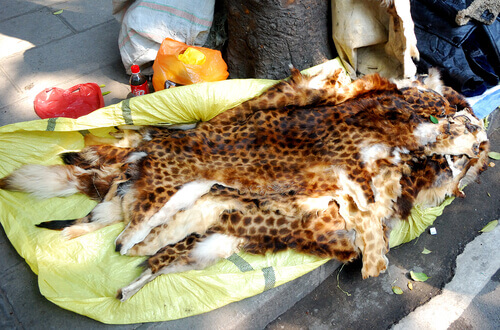Effective Measures Against Poachers Must Be Taken!


Written and verified by the lawyer Francisco María García
In a world full of endangered animal species, it’s essential to combat the plague of poachers. It’s not just a matter of theory, effective measures against poachers are vital! So, the necessary means, policies and personnel should be established in order for poaching to cease.
Animals that have suffered most from poaching in recent years have been rhinos, gorillas, tigers and elephants. But there are many more species suffering. So, how can we avoid this situation? What can we do against poachers?
A problem in many countries
Illegal hunting of animals, also called poaching, is a real problem in many countries, especially in Africa, South America and Southeast Asia. These are areas of the world with unique native species that are difficult to find in other countries.
Alongside poaching, these parts of the world generate a truly lucrative business: the illegal wildlife trade of endangered species. Whether for sport, or as a hobby, animals are often innocent victims.
There are many personalities that we’ve met over the years involved in this dreadful practice. We’re talking here about well-known politicians, actors and actresses, and even kings and heads of state.
One of the main trades derived from the poachers’ business is that of ivory. Elephant tusks are used for medicinal, cosmetic and, above all, decorative purposes.

UN measures against poachers
At different meetings, the United Nations (UN) has passed various resolutions in which countries have committed themselves to reduce poaching and the subsequent illegal wildlife trade of endangered species.
In short, it’s a matter of enacting laws, stiffening penalties and sanctions, and then enforcing compliance. One of the key aspects is to formalize poaching as a serious crime.
New technologies and artificial intelligence
One of the best-known examples of the use of artificial intelligence against poachers is PAWS (Protection Assistant for Wildlife Security) application.
This tool, developed by the University of Southern California, uses complex mathematical algorithms. Among the factors considered are data on the behavior of poachers and information from surveillance patrols.
What’s the Wildlife Crime Tech Challenge? It’s a project that combines science and technology devices and applications to combat poaching.
The number of projects integrated by the WCTC exceeds 300 and more than 52 countries have joined. Moreover, anyone, with help and advice from their country’s authorities, can submit suggestions.

Some of the winning projects are these:
- A portable device with the ability to do DNA testing in less than an hour.
- An application for smartphones, with which users can differentiate in real-time if the animal in front of them is part of a protected species, if it’s been captured illegally, etc.
- Sensors that use scent to locate animals hidden in cargo or luggage.
What measures are effective against poachers?
To combat the problem of poachers, there are many proposals and ideas waiting for implementation:
- Firstly, banning the international ivory trade is one of the most effective measures.
- The illegal wildlife trade of animals and endangered species is a regrettable situation that must be eradicated.
- The number of patrols and agents protecting these animals should increase; we should also provide personnel with appropriate technology and resources.
- Last but not least, education and awareness of all people worldwide that they shouldn’t buy products or clothing derived from endangered species.
DNA against poaching
The comparison of DNA and its use makes it possible to locate the areas with the highest poaching rates. Also, let’s not forget that the area between Tanzania, Mozambique, Congo, Gabon and Cameroon has the highest percentage of poaching.
In South Africa, one of the most affected countries by poaching of endangered animals, the competent authorities are seeking solutions. RhoDIS is a powerful database that compares samples of animals that are still alive. Subsequently, these samples are compared to the remains of animals that have been killed and traded.
Drones and GPS
Finally, APE technology consists of software capable of locating endangered animals and poachers. The system integrates specialized drones, infrared cameras, GPS and even airplanes.
In a world full of endangered animal species, it’s essential to combat the plague of poachers. It’s not just a matter of theory, effective measures against poachers are vital! So, the necessary means, policies and personnel should be established in order for poaching to cease.
Animals that have suffered most from poaching in recent years have been rhinos, gorillas, tigers and elephants. But there are many more species suffering. So, how can we avoid this situation? What can we do against poachers?
A problem in many countries
Illegal hunting of animals, also called poaching, is a real problem in many countries, especially in Africa, South America and Southeast Asia. These are areas of the world with unique native species that are difficult to find in other countries.
Alongside poaching, these parts of the world generate a truly lucrative business: the illegal wildlife trade of endangered species. Whether for sport, or as a hobby, animals are often innocent victims.
There are many personalities that we’ve met over the years involved in this dreadful practice. We’re talking here about well-known politicians, actors and actresses, and even kings and heads of state.
One of the main trades derived from the poachers’ business is that of ivory. Elephant tusks are used for medicinal, cosmetic and, above all, decorative purposes.

UN measures against poachers
At different meetings, the United Nations (UN) has passed various resolutions in which countries have committed themselves to reduce poaching and the subsequent illegal wildlife trade of endangered species.
In short, it’s a matter of enacting laws, stiffening penalties and sanctions, and then enforcing compliance. One of the key aspects is to formalize poaching as a serious crime.
New technologies and artificial intelligence
One of the best-known examples of the use of artificial intelligence against poachers is PAWS (Protection Assistant for Wildlife Security) application.
This tool, developed by the University of Southern California, uses complex mathematical algorithms. Among the factors considered are data on the behavior of poachers and information from surveillance patrols.
What’s the Wildlife Crime Tech Challenge? It’s a project that combines science and technology devices and applications to combat poaching.
The number of projects integrated by the WCTC exceeds 300 and more than 52 countries have joined. Moreover, anyone, with help and advice from their country’s authorities, can submit suggestions.

Some of the winning projects are these:
- A portable device with the ability to do DNA testing in less than an hour.
- An application for smartphones, with which users can differentiate in real-time if the animal in front of them is part of a protected species, if it’s been captured illegally, etc.
- Sensors that use scent to locate animals hidden in cargo or luggage.
What measures are effective against poachers?
To combat the problem of poachers, there are many proposals and ideas waiting for implementation:
- Firstly, banning the international ivory trade is one of the most effective measures.
- The illegal wildlife trade of animals and endangered species is a regrettable situation that must be eradicated.
- The number of patrols and agents protecting these animals should increase; we should also provide personnel with appropriate technology and resources.
- Last but not least, education and awareness of all people worldwide that they shouldn’t buy products or clothing derived from endangered species.
DNA against poaching
The comparison of DNA and its use makes it possible to locate the areas with the highest poaching rates. Also, let’s not forget that the area between Tanzania, Mozambique, Congo, Gabon and Cameroon has the highest percentage of poaching.
In South Africa, one of the most affected countries by poaching of endangered animals, the competent authorities are seeking solutions. RhoDIS is a powerful database that compares samples of animals that are still alive. Subsequently, these samples are compared to the remains of animals that have been killed and traded.
Drones and GPS
Finally, APE technology consists of software capable of locating endangered animals and poachers. The system integrates specialized drones, infrared cameras, GPS and even airplanes.
This text is provided for informational purposes only and does not replace consultation with a professional. If in doubt, consult your specialist.








